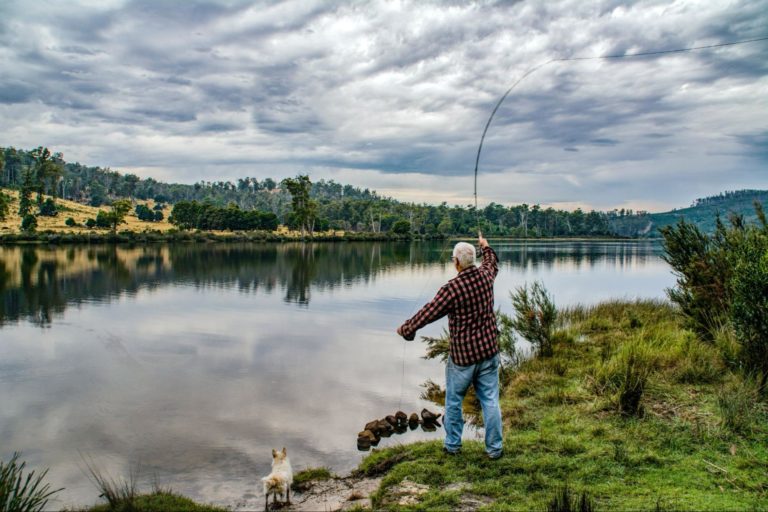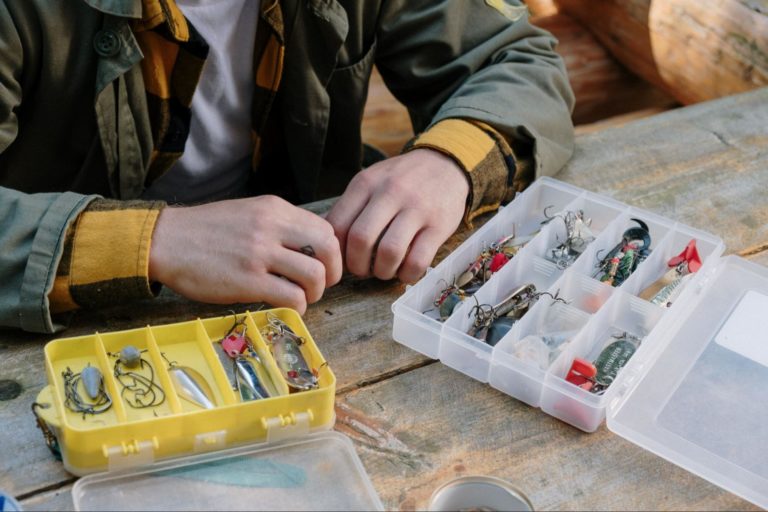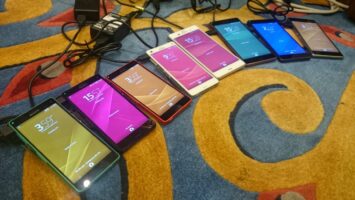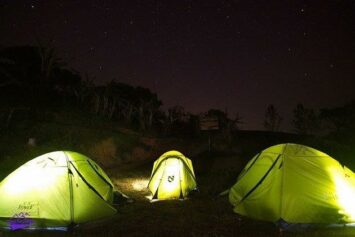Fly fishing first originated in the 2nd century in modern-day Rome. While fly fishing wasn’t as advanced as it is today, it began gaining popularity quickly as people enjoyed the idea of mimicking a fly drifting on the water’s surface.

If you have an interest in fishing in general, the great outdoors, patience, and a bit of time, fly fishing is the sport for you. From the crisp air to the beaming water, there are lots of things to love about fly fishing. Here’s a guide on how to have the best possible experience!
Quick Navigation
ToggleFlying Fishing Gear
Like every other sport in the world, you’re going to need specialized fishing gear to have the best experience possible. Fly fishing consists of lots of gear, but not all gear is mandatory.
As far as clothing goes, you’ll want a good shady hat, polarized sunglasses, vest, waders, and boots. All these can be easily packed into your fly fishing backpack.
- Fishing Hat: Bucket hats are great for all-around sun protection coverage and include adjustable chin straps so your hat won’t fly away while casting.
- Polarized Sunglasses: Sunglasses are essential when fishing, polarized sunglasses allow you to see fish easily in the water and eliminate the water’s glare from the sun.
- Fishing Vest: Fishing vests allow you to carry fly floatants, leaders, and knot tying tools with you into the water in a way that is both organized and convenient. Vests are most popular among trout fishers. Salmon fishers can usually fit everything into their wading jacket pockets.
- Fishing Waders: Waders provide an extra layer of warmth when you plan on entering the water. Waders are absolutely essential if you are entering the water during wintertime or in a colder and less favourable weather conditions.
- Waterproof Fishing Boots: Boots are necessary to protect your legs from puncture wounds. When casting, many anglers catch their hooks and lures on their legs. Wearing boots is vital to protecting yourself from unnecessary injuries.
Flies and Fly Boxes
A fly box is an angler’s pride and joy. For starting out, an assortment of flies that is fairly cheap will do. Beginners lose flies frequently and this can get costly. This box will contain everything you need and give you an idea of which flies are the best for you.

Flies can also get lost very easily and are a pricey purchase; therefore, there’s no need to splurge on expensive and premium ones at the very beginning.
Streamers
Streamers resemble baitfish and are the most helpful fishing flies for catching big fish. Streamers are most used near riverbanks, riffles, shallows of lakes, and around boulders. Using streamers near these areas will get lots of hungry fish to your line.
Dry Flies
Dry flies are tied out of floating material and are the best flies for catching trout. These flies represent insects that float and land on top of the water.
Wet Flies
Wet flies resemble insects that live and grow below the water’s surface. These insects hatch and later float to the surface. Wet flies are also great for catching trout below the surface. They imitate caddis, blue-winged olives, stoneflies, and mayflies.
Nymphs
Nymph flies imitate insect larva and the nymph stages of aquatic insects which are found in streams, rivers, ponds, and lakes. With nymphs, you can catch smaller fish such as shrimp.
Terrestrials
Terrestrial flies include bees, wasps, and ants. These flies were named terrestrial due to their origin being the land. Terrestrial flies are highly recognized by trout due to their high presence in the summer.
Saltwater Flies
Saltwater flies include shrimp, minnows, and other baitfish. The Clouser Deep Minnow will help you catch just about any saltwater fish species and is the most popular saltwater fish fly.
Picking the Best Fishing Rods and Reels
You’ll need different rods and reels depending on where you’ll be fishing and the species you’re targeting.
A good tip to remember is that the bigger your rod is, the bigger your fish will be. For example, a 5-weight rod is perfect for most average-sized trout. This is a mid-tier fly rod that will get you fish that are neither too big nor small.
The best thing you can do is go to a fishing store and explain that you’re looking for a beginner rod and reel set. The employees should be able to help you find a beginner-friendly set that doesn’t break the bank!
Fly Fishing Tools
Believe it or not, fly fishing requires lots of tools. Here are some of the essentials.
Tippets
After a long day of fishing, you’ll notice that the end of your leader may need some repairs. Tippets are used to repair the ends of leaders, so you’ll want to have about 5 of them on hand.
Fly Floatant
You definitely don’t want to skip out on any fly floatant when fly fishing or you’re going to have an unsuccessful evening.
Fly floatant is a waxy paste that you rub on both the leader and dry fly. Essentially, the waxy paste is what causes the floating.

Landing Net
Landing nets can be attached to your fishing vest and should be made of wooden material with a rubber mesh attachment.
Landing nets are used to scoop up your caught fish to avoid any injuries to your hands. You don’t need to make a huge investment on one either, just make sure that it’s light and sturdy.
Nippers
Nippers are used to cut monofilament leaders.
Hemostats
Hemostats eliminate the need to risk your hands when removing flies. They grip the fly and remove it from your caught fish so you don’t have to!
Creel
A creel is a basket used for keeping fish cold during transport. If you plan on releasing all your fish, you won’t need a creel; however, if you want to eat your fish, a creel is mandatory.
Practice Fly Casting
You can practice fly casting at home with an old fly. Make sure to cut the hook off before practicing on land to avoid a big catastrophe.

Casting includes mastering casting strokes and an abrupt stopping motion. You’ll want the line to travel back and forth through the air. The line should travel in front and behind you.
Once the fly connects with the water, you’ll need to mend the line. Mending the line ensures that the fly floats naturally with the flow of water. If the fly floats unnaturally then you’ll have to recast the line.
The easiest way to learn casting is from an experienced fly fisher or through a video – and of course, through your own practical experience!
Conclusion
Whether you’re looking to fly fish in saltwater or freshwater, connecting with the great outdoors can be a great experience through fly fishing. All you have to do is follow our guide to have a successful trip, and maybe try casting a line before you go. So don’t forget your creel and have a great time!


